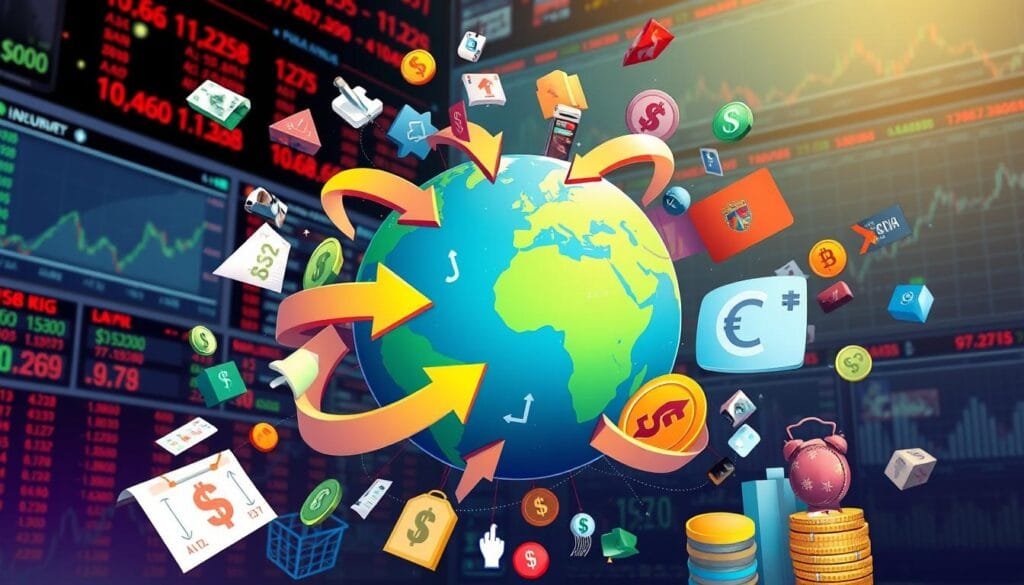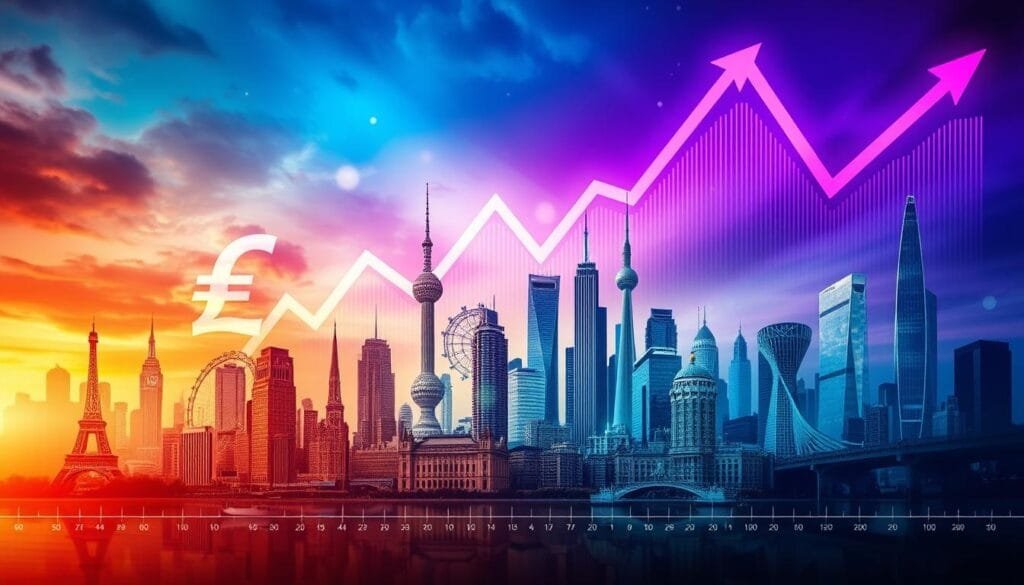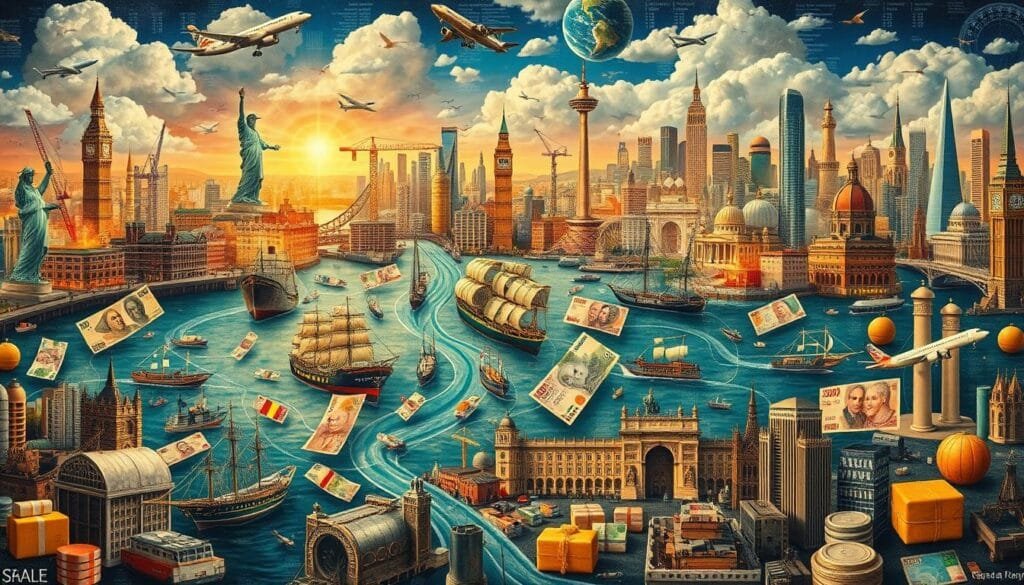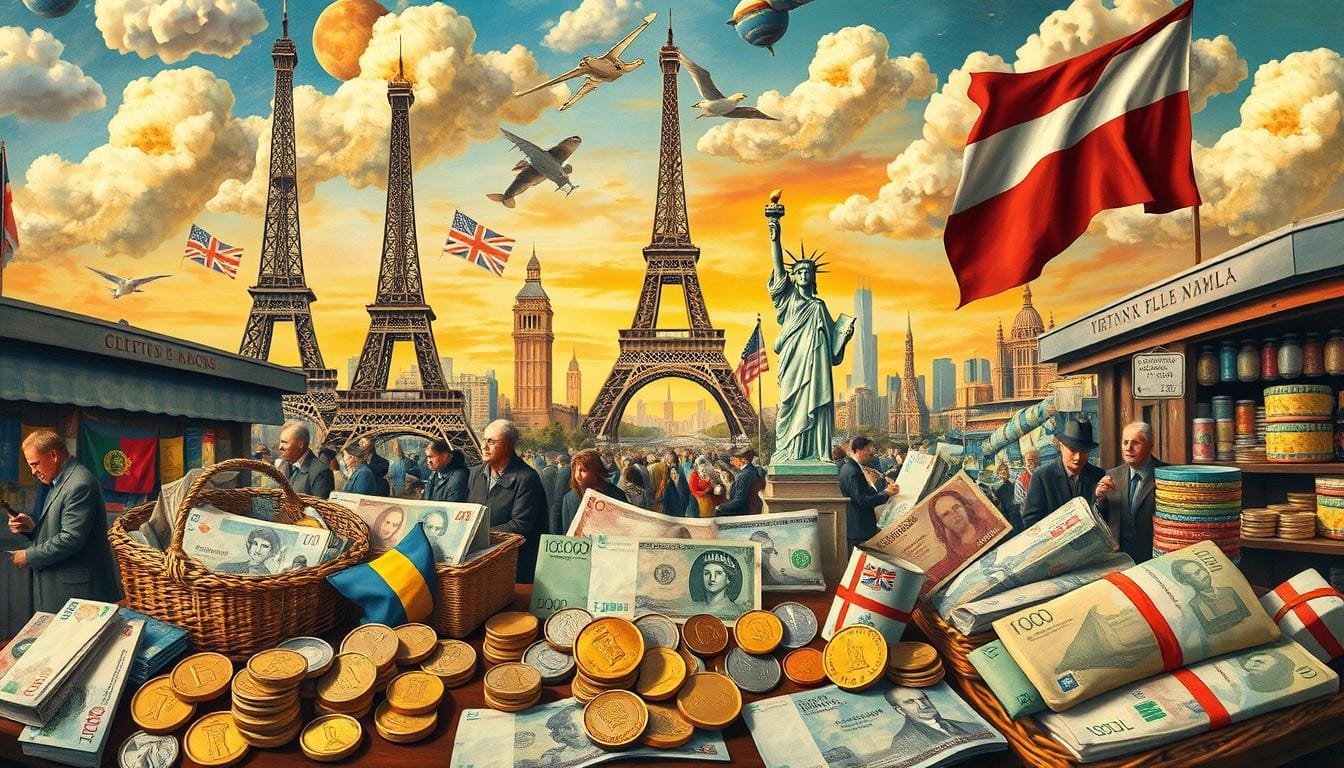Have you ever thought about the value of a dollar when you travel abroad? The importance of currency exchange economics is huge. It shapes how we spend, invest, and interact on a global scale. The movement and value of money affect things like prices, international trade, investments, and even vacations. Through understanding currency exchange basics, we learn about what powers the massive $6 trillion-a-day market. Are the values of currency just indicators of economic health, or is there more to it?
Key Takeaways
- The foreign exchange (FX) market processes over $6 trillion in daily trades.
- The U.S. dollar is the reference currency for about 88% of all FX transactions.
- Decoding the “Big Mac index” helps illustrate purchasing power parity across different currencies.
- The euro, introduced in 1999, unified 11 European countries under a fixed exchange rate.
- Financial institutions have an increasingly dominant role in the FX market beyond traditional importers and exporters.
- The carry trade strategy capitalizes on interest rate differentials to inform FX investment decisions.
- Country-specific economic and political conditions significantly influence currency volatility.
Introduction to Currency Exchange
Currency exchange is about trading currencies in the forex market. This makes international trade and business possible. Currency exchange introduction teaches the basic principles and terms.
Forex trading basics are key to understanding currency exchange. You can exchange money at places like airports and banks, or online. The exchange rate tells how much one currency is worth in another. It changes due to market demand and fees.
The bid-ask spread is the difference between what buyers pay and sellers receive. For example, if EUR is USD 1.30 to buy and USD 1.40 to sell, the spread is USD 0.10. This spread affects the cost of exchanging currency.
Exchange fees also differ a lot. Buying EUR 5,000 at an airport might cost USD 7,000. Selling the same amount could return USD 6,500. The exchange makes a profit from this difference.
The forex market sees trillions of dollars traded every day. This creates liquidity, but also makes exchange rates and fees complex. It’s wise to check local banks or credit unions for better rates.
Digging into forex trading basics and how currency exchange works shows the importance of being informed. Knowing more can lead to better deals for travel or business.
What Is an Exchange Rate?
An exchange rate is key in world economics. It shows how much one currency is worth in another. This affects travel, investments, and a nation’s economic health. Let’s explore the exchange rate definition and why it’s vital for the global economy.
Definition and Importance
An exchange rate shows the value of one currency for another. It’s crucial for trade, travel, and investments across borders. For example, exchanging $1,000 might get you about 872.60 euros at a bank rate of 1.146. To get 1,500 euros, you’d need $1,719 if the rate stays the same.
Exchange rates change all day due to market demand and economic events. They work non-stop in the forex market during the week. These rates affect our daily lives, how far our money goes, and the economy at large.

Types of Exchange Rates
There are two main kinds of exchange rates: fixed and floating exchange rates. Governments set fixed rates, often linked to a major currency like the U.S. dollar. For example, banks might adjust the CAD/USD rate from 0.75 to 0.7725.
Floating rates move with supply and demand in the forex market. They can change a lot. For instance, the EUR/USD might be 1.113, but banks charge 1.146, adding a fee of about 3%.
Knowing these rates is key for anyone in international business or who travels. The forex market’s huge daily volume highlights the exchange rate’s role in the world economy.
How Exchange Rates Fluctuate
Grasping how exchange rate fluctuations work is key in the global finance realm. These changes stem from economic indicators and market conditions. The forex market dynamics include various factors that shift currency values daily.

1. Interest Rates: To control the economy, central banks adjust interest rates. High rates draw foreign capital, boosting the local currency. Lower rates can lower a currency’s value.
2. Inflation: A currency’s worth is greatly influenced by inflation. For example, Japan and Switzerland kept strong currencies with low inflation. But high inflation reduces purchasing power and devalues a currency.
3. Economic Performance: The economic health of a country affects its currency. Factors like GDP growth and job rates matter. Also, recessions decrease investor trust, harming currency value.
4. Political Stability: Political issues lead to capital fleeing to safer places. This drops the currency value. Meanwhile, political calm attracts investment, which can lift the currency’s value.
5. Market Speculation: Speculation and investor expectations lead to exchange rate fluctuations. News impacting expectations can make currencies volatile.
6. Trade Balances and Current Account Deficits: If a country imports more than it exports, it faces a deficit. This ongoing issue can lower the currency’s value as demand for foreign currency increases.
7. Government Debt: High government debt might push away investors due to inflation fears and default risk. This impacts the currency negatively. Agencies like Moody’s evaluate these risks.
8. Terms of Trade: Terms of Trade (TOT) compare export and import prices. If export prices increase more, the currency value goes up. But if they fall behind, the currency may drop.
These points show why knowing factors affecting exchange rates is essential. Forex traders, corporations, and governments need to stay on top of global economics. As economies change, so do exchange rates, due to complex forex market dynamics.
Factors That Influence Exchange Rates
There are many elements that affect how exchange rates change. This is crucial knowledge for anyone trading in forex. Interest rates, economic conditions, political stability, and market speculation all influence currency values around the world.
Interest Rates
The effect of interest rates on a country’s currency is huge. Central banks like the Federal Reserve in the United States adjust these rates. They do this to control inflation and boost the economy. For example, when the U.S. raises its rates, the dollar usually becomes stronger, attracting more investments.
Economic Performance
Economic health is shown through GDP growth, job rates, and inflation levels. When an economy does well, its currency becomes more attractive. This is because more investors want in. But if the economy struggles, its currency might lose value. Traders always watch these signals to judge a country’s financial health.
Political Stability
Politics can directly change currency values. Countries with stable governments are more likely to attract investments. This stability suggests reliable economic policies which lowers risks for currency values. On the other hand, places with lots of political drama often see their currency fall. Investors move their money to safer options during uncertain times.
Market Speculation
Speculating in forex has a big role too. Traders guess where currencies will go based on many factors. These include interest rates, economic news, and politics. They use different methods, like the carry trade, hoping to profit. But this speculation can also make exchange rates bounce around more.
Understanding the links between these factors is key in forex trading. Investors and traders need to keep up with interest rates, economic trends, and political news. This way, they can make smarter decisions.
What Is Currency Exchange Economics
Currency exchange economics looks at how currencies are valued and traded worldwide. It uses economic theories to explain what determines exchange rates. These include macroeconomic conditions and international finance dynamics.
This field’s core idea is currency valuation. Many factors like interest rates, inflation, and political stability affect it. Most currency trading happens in the Forex market. This market is the biggest globally, with transactions worth about $5.3 trillion daily.

The table below shows the daily trading share of different currencies as of April 2016:
| Currency | Daily Trading Share (%) |
|---|---|
| U.S. Dollar | 87.6 |
| Euro | 31.3 |
| Japanese Yen | 21.6 |
| British Pound | 12.8 |
| Australian Dollar | 6.9 |
| Canadian Dollar | 5.1 |
| Swiss Franc | 4.8 |
| Chinese Yuan | 2.6 |
We also study how these currencies affect global trade and economic relationships. Events like Bretton Woods and the Nixon Shock in 1971 have influenced how we value currency today.
By learning these economic theories and examples, we get a full picture of currency’s role in the global economy. This knowledge is crucial for those in international finance, trade, or investment. It aids in making smart decisions and managing risks well.
The Forex Market Explained
The foreign exchange market, or forex, trades the world’s currencies. It’s the biggest securities market, with trillions of dollars exchanged daily. This market runs 24/7, only stopping on weekends. By understanding the forex market structure, we learn how it works. We also see why it’s always moving and changing.
Market Structure
Forex has various market types: the spot, forwards, and futures markets. The spot market deals with immediate currency delivery. The forwards and futures markets handle contracts for future rate exchanges. As of April 2024, these markets’ daily volume was over $1.165 trillion. Forex trading platforms keep them alive 24/5 around key financial hubs.
In forex, currencies are traded in pairs. The U.S. dollar (USD) is very active, often paired with the euro (EUR) and others. Most currency deals are done in two days. But, USD vs. CAD trades settle the next day. The Chicago Mercantile Exchange trades forex futures too. These offer more ways to speculate or hedge in currency.
Key Players
Forex’s main players include big international banks, central banks, and currency speculators. Big banks like JPMorgan Chase and UBS play a large role. Central banks, like the Federal Reserve, use forex to help their economies. They may adjust rates or buy and sell currencies directly.
Currency speculators and traders add to the market’s liquidity and volatility. Corporations use forex to protect against currency risk. Governments need it for policy and reserves management. Understanding how the forex market operates shows us the roles these players have. It shows their impact on the global economy and trade.
In summary, dissecting the forex market and identifying its key participants explains market dynamics. It shows their effect on global trade and financial stability.
Impact of Exchange Rates on Global Trade
Exchange rates play a big role in world trade for businesses and governments. They affect how much it costs to buy and sell goods overseas. This reflects on a country’s economic condition.
Imports and Exports
Impact on imports and exports is big. Imagine the U.S. dollar getting stronger compared to the Japanese yen. This means U.S. goods cost more for Japanese buyers, which may decrease U.S. exports. At the same time, Japanese goods cost less in the U.S., increasing imports.
Changes in exchange rates can change trade balances, growth, and inflation. A weaker currency helps exports by making goods cheaper overseas. A stronger currency does the opposite, making imports cheaper.
Foreign Investment
Exchange rates also affect forex investment. When the U.S. dollar drops, investments in dollars look cheaper. This can lead to more foreign investments. For instance, if the South African rand falls from 11 to 15 per dollar, the country becomes more attractive for investment.
Exchange rate changes can make a big difference for investors looking for opportunities. They look for chances to convert currency and assets profitably.
Tourism
Tourism economics are greatly influenced by exchange rates too. A stronger U.S. dollar lets American tourists get more for their money abroad. For instance, if 1 dollar buys more rand, destinations like South Africa become more appealing. This boosts South Africa’s economy as more U.S. tourists visit.
On the other hand, a weaker dollar might stop U.S. tourists from going places where the exchange rate is bad for them.
Overall, exchange rates have a wide impact on international trade, investment, and tourism. Knowing how these work is key for dealing with the global economy.
Conclusion
This article explored the complex world of currency exchange and its importance in the global economy. We learned how exchange rates work and the various factors that affect them. These insights help shape economic policies, business strategies, and global financial trends.
The foreign exchange market sees daily transactions worth around USD 7.5 trillion. This is mainly due to major currencies like the USD, EUR, and JPY. Such a huge trading volume shows how vital forex is for global economic interactions. It matters a lot to financial institutions, governments, and businesses.
Looking ahead, we see that technology and changing economic conditions will keep evolving the forex market. This market works non-stop, 24 hours a day, throughout the business week. It offers access and flexibility to people all over the world. This ensures it continues to influence the global economy, bringing both chances and challenges for everyone involved.
To sum up, understanding currency exchange economics highlights how exchange rates affect the economy. They impact trade, investment, tourism, and even political stability. Knowing how currencies interact helps us see their role in the global economic picture. As we move forward, deep knowledge and smart planning will be key to making the most of forex market dynamics for economic growth and stability.
FAQ
What are the basics of currency exchange?
Currency exchange lets us trade different countries’ money in the forex market. This is key for international trade and business. Each country has its own money. It’s vital to know how these are valued and traded globally.
How does currency exchange work?
It involves buying and selling money at current rates. Individuals and companies do so through banks or online. This is part of international transactions.
What is an exchange rate?
An exchange rate is how much one currency is worth in another. It affects the cost of going abroad and importing goods. This rate is crucial for a country’s economy.
Why are exchange rates important?
They matter because they change how much goods cost to import and export. They influence investments and tourism. This shapes a nation’s economic growth.
What are fixed and floating exchange rates?
Fixed rates are set by a government. Floating rates change with market demand and supply. Both impact how countries trade on the global stage.
How do exchange rates fluctuate?
Rates change with economic signs and market conditions. News and events also cause these shifts. This volatility affects financial decisions.
What factors influence exchange rates?
Interest rates, a country’s economic health, and political stability matter. Market speculation also plays a part. Together, these affect a currency’s value.
How do interest rates affect exchange rates?
Higher interest rates can make a currency more attractive. This can increase its value. It’s about the returns on currency investments.
What role does economic performance play in exchange rates?
A strong economy draws foreign investment. This boosts demand for its currency. The currency’s value goes up as a result.
How does political stability impact exchange rates?
Stable politics lead to predictable economic policies. This attracts investors. It means more stability and value for the currency.
What is market speculation in forex trading?
Speculation involves making trades based on future currency movements. This can cause big short-term changes in exchange rates. It’s based on predictions.
What is currency exchange economics?
It looks at how currencies are valued and traded globally. This field combines finance and economics. It offers insights into global trade and relationships.
How does the forex market operate?
The forex market is a 24-hour, decentralized global market. Here, currencies are traded. It includes big players like banks and governments.
Who are the key players in the forex market?
They include international banks, central banks, and speculators. Multinational companies and governments are also involved. They all play a part in currency trades.
How do exchange rates affect global trade?
Exchange rates change import and export costs. A strong currency makes imports cheaper. But it makes exports costlier. This affects trade balances and growth.
How do exchange rates influence foreign investment?
They impact the returns on international investments. Investors seek currencies expected to gain value. This strategy aims for higher profits.
What is the impact of exchange rates on tourism?
Tourist destinations become more affordable with favorable rates. This can boost local economies by attracting more visitors. It’s all about the cost of travel.
